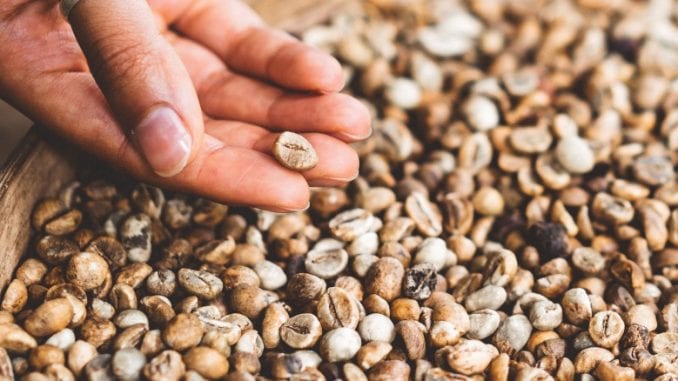
We continue to explore global coffee drinks, focusing today on green-coffee extract and how it sparked the first wave of coffee beverages.
BY CHRIS KORNMAN & SANDRA ELISA LOOFBOUROW
SPECIAL TO BARISTA MAGAZINE
Cover photo by Joshua Newton
In many places, coffee is a culinary newcomer, part of a relatively recent and still present colonial history. Whether it’s because of blossoming production and global trade, or because of the physical effects that a cup of coffee can impart, nearly every culture has developed its own particular coffee tradition. In places with strong pre-colonial culinary traditions, coffee was absorbed and adapted into existing practices, adding to the cultural miscegenation that colonialism always creates. Food and beverage traditions in particular, being intensely personal, have a way of absorbing new practices and making them their own. As an industry that prides itself on its global community and an adventurous palate, specialty coffee has a great opportunity to learn from varied and tasty traditions of coffee consumption.
In this series, we explore regional and cultural coffee beverages and the particular confluence of historical and social circumstances that brought these beverages into existence. We’ve explored the history of café de olla and its importance and revival in Mesoamerica, and then jumped to Senegal to explore café Touba, a drink made with coffee and Selim pepper, and how it is enjoyed today. Now, Chris Kornman will explain the history of green-coffee extract—and how it sparked a worldwide love affair with coffee.
Part I – Green-Coffee Extract was the First Wave
In Yemen’s port of Aden around the middle of the 15th century, a Sufi mystic named Jamal al-Din Abu ‘Abd Allah Muhammad ibn Sa’id, (known as Dhabhani), introduced and popularized a drink he’d encountered while traveling to the Horn of Africa, likely to the city of Harar. The beverage he tried would have been called bun or buna, and that name survived his return to the Arabian Peninsula in the form of bounya, a drink made from crushing and boiling green coffee beans to create an extraction, like a strong tea from raw coffee beans.
Its similar stimulant properties to kafta—an already popular drink made from khat leaves—led to its adoption for use during the sect’s midnight prayers, and the term kafta was co-opted and applied to the coffee beverage. Eventually kafta would be corrupted to qahwah in classical Arabic and kahveh in Turkish. From there, it’s not hard to imagine the linguistic leap to the café of the romance languages.
While qishr is often regarded as the iconic Yemeni coffee drink, made from the husk of the the dried cherry (not unlike cascara), boiled and spiced, it is bounya that would eventually evolve from raw extraction into roasted, ground, brewed, and filtered coffee.
Green extract was the drop that whetted the world’s appetite for coffee.
But the tradition of boiling unroasted coffee beans predates the Sufis of Aden, as well as the Abyssinian farmers and traders of Hararghe during the Islamic Golden Age. Both in Arabica’s home of Western Ethiopia and in Northern Tanzania near the origins of Robusta, unroasted coffee—boiled and sometimes smoked—was chewed or the extraction could be imbibed unfiltered.
Modern interest in green-coffee extract has been revived, though not really for culinary purposes. In 2012, Dr. Mehmet Oz popularized a theory that the high proportion of chlorogenic acid in green coffee could stimulate weight loss. During roasting, chlorogenic acid degrades into quinic acid, and so it is technically true that more of it exists in the unroasted beans.
However, there are some pitfalls to this method of preparation. Boiled green coffee is not especially palatable—all that chlorogenic acid in the absence of caramelized sugars is terrifically bitter. Poor-quality green coffee also runs a higher risk than roasted of causing potential health issues: Many compounds that burn off (like mold) or reduce in concentration (like ochratoxin) during roasting will adversely affect the consumer’s well-being if ingested in high quantities.
There’s also a drawback to using green-coffee extract as a weight loss supplement: It doesn’t seem to work. One of the studies promoted by Dr. Oz was falsified, and in recent years, multi-million dollar settlements and lawsuits for green-coffee extract products promoted by the TV personality have tarnished the reputation of both the extract and its promoter.
But, if we’re unconcerned with health (benefits or detriments), then surely there’s a way to experience coffee like its earliest drinkers in a way that appeases modern gustatory sensitivities. As part of a lecture and tasting series, Sandra undertook the challenge. Gleaning inspiration from ancient practices and fusing them with regional flavors from Indonesia, she crafted refreshing drinks using green-coffee extract. We will share her process and recipes in Part II of this article coming soon.

